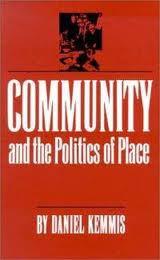Today—and often—I am of divided mind and body, and probably divided soul as well. Last week I was in Baton Rouge, Louisiana and Tempe, Arizona. Next week, I will be in Boston Massachusetts and Washington, D.C. Today, I am in 97214, making crepes and trying to keep a sense of home on this little lot on a busy street, across from one of America’s beautiful parks. I walk outside multiple times a day to see if the rhubarb has any new leaves. (I am happy to report that as of last check-in, it does). In other words, I spend the weeks trying to understand the country, the weekends trying to understand this little spot, trying to be a good steward of both. I wonder how I am doing at either.
My dear friend Daniel Kemmis once asked me: How do you feel about being part of national organization? How can anyone serve the whole country? That last question is one that lingers, that stings a little, that haunts. Truth is, Dan became my friend because I tracked him down and forced myself on him many years ago now after reading his fine, life-changing book Community and the Politics of Place. My old copy, that is tattered and full of notes and highlights, still sits on my desk. I refer to it in conversation at least once a month. It is now 23 years old, and the questions and provocations it raises are as relevant and necessary as ever.

The thesis—which is deeply and overtly Jeffersonian—is this: “[T]he demise of public life has to be understood in terms of space (or place) as well as time. Putting it more positively, public life can only be reclaimed by understanding, and then practicing, its connection to real, identifiable places.“ That rings true as I talk to Louisiana legislators who reflect on the history of colonialism and settlement patterns and how they affect—even to this day—the relationship between the branches of government. And Oregon legislators talk about political identities that are not driven by party but rather by whether the individual represents a district on the East or the West side of the state. Water rich, water poor. Open land rich, open land poor. These connections to particular places and their history really matter in how issues are framed and ultimately how they are resolved.
But on the other hand, there are a set of issues that seem to be neither locally created nor locally solvable: the power of wealthy special interests, the national sweep of term limits, the demise of local media outlets, winner-takes-all partisanship. Those issues are common across the states and seem to be driven by forces that are at least national—if not global—in scale. If that is the case, attempting to create entirely local solutions would be both inefficient and likely ineffective.
Often times, it feels like a personal or a professional quandary, one that’s about me and my colleagues and how we should be spending our limited time and resources. But, maybe that’s not it at all. Maybe it is really an existential quandary, a question of identity for both the nation and its citizens. I’m not really sure. But, rather than rush to resolve the confusion, the quandary, the questions, for now I am going to do my best to live with them them. As Dan advises, “[w]hen the effort to survive comes to rely upon shared and repeated practices like barn raising, survival itself is transformed; it becomes inhabitation. To inhabit a place is to dwell there in a practiced way, in a way which relies upon certain regular, trusted habits of behavior.” So for today, I am going to just wonder and mull and make crepes. I am going to inhabit my little part of the Republic, I am going to try to bring body and spirit back together
Dan’s book ends here, taking solace in T.S. Eliot’s Four Quartets—and for today, so do I, in my kitchen and my garden, with dishes to do and the rhubarb coming up:
We shall not cease from exploration
And the end of all our exploring
Will to be to arrive where we started
And know the place for the first time.
And oh, here is the recipe for easy, everyday crepes:
INGREDIENTS
- 1 cup all-purpose flour
- 2 eggs
- 1/2 cup milk
- 1/2 cup water
- 1/4 teaspoon salt
- 2 tablespoons butter, melted
DIRECTIONS
- In a large mixing bowl, whisk together the flour and the eggs. Gradually add in the milk and water, stirring to combine. Add the salt and butter; beat until smooth.
- Heat a lightly buttered cast iron pan over medium high heat. Pour or scoop the batter onto the griddle, using approximately 1/4 cup for each crepe. Tilt the pan with a circular motion so that the batter coats the surface evenly.
- Cook the crepe for about 2 minutes, until the bottom is light brown. Loosen with a spatula, turn and cook the other side. Serve hot with powdered sugar and lemon juice.
